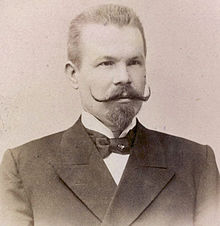


Finnish jewelers ( Fin. Suomalaiset kultasepät ) are jewelers from Finland and the Grand Duchy of Finland .
Content
History
The formation of the Finnish jewelers' own community historically occurred under the influence of craftsmen from Sweden , Denmark , the Russian Empire and Germany . In keeping with the spirit of their time, Finnish jewelers, along with craftsmen from other European countries, imitated jewelry makers in the field of jewelry - the French and Swiss Bode, Duke, Jean Odio and Posi (rococo court style from the time of Louis XV), and .
XVIII century
The first Finnish jewelers appeared in St. Petersburg shortly after its foundation in 1703. The names of many masters of the 1720s, who had their own workshops in the capital of the Russian Empire, are well known. At the time of Catherine II, some of the Finnish jewelers carried out orders of the imperial court. One of the first Finnish craftsmen of the mid-18th century, educated in St. Petersburg and later becoming a supplier to the imperial court, was Juhan Blum . Also known is his colleague Samuel Malm , who studied juridical business in the capital of the Russian Empire. The masters worked in the style of French neoclassicism ( Louis XVI style) and in the rococo style . Master Karl Bredenberg , on the contrary, came to Russia as an already-established master. In the modern collection of the Hermitage there are many exhibits of another Finnish jeweler of the late 18th - early 19th centuries - Peter Enerut , who worked in the neoclassical style.
XIX — XX centuries
In the 19th century, due to an increase in the turnover of jewelry production, the number of jewelry craftsmen increased and, as a result, their specialization began. In the 1800s, the number of Finnish jewelers in the guild of gold and silver masters in St. Petersburg was a fourth. Some of them, having received education and experience in their business, returned to the Grand Duchy of Finland , where they learned the burgher rights and formed their own workshops, but most settled in the capital of the Russian Empire .
In the Empire style , which came into fashion in the reign of Alexander I , Finnish masters Johan Okerblum , Gustav Lindgren , Heinrich Petman, Thomas Scott, Heinrich Tallberg, Gustav Abraham Bernstrom, Karl Gustav Savary and Heinrich Tupper worked. The natives of the cities of the southern coast of Finland, who received the basics of mastery in their homeland, all later received the status of imperial court suppliers in St. Petersburg, which testifies to their high professionalism as jewelers.
The Finnish masters of the 1830–1840s — Frederick Lönnqvist, Adolph Sper and Elias Mudig made coffee and tea sets made in the late Empire and neorococo styles in their workshops. Their products were in demand not only among the aristocracy of St. Petersburg, but also enjoyed wide demand in Finland (the late Empire style was named Biedermeier in the Grand Duchy of Finland).
The first jeweler-manufacturer founded in Finland a factory for the production of silver and bronze was the educated and experienced in St. Petersburg Karl Johan Tegelsten . He adhered to the English style and collaborated with the large English retail store of the popular Nicholls & Plincke, commonly called Magasin Anglais.
Andreas Kurki became the first Finnish master specializing in the manufacture of objects of gold.
The demand for products made according to the Russian folk style patterns that appeared during the reign of Nicholas I inspired Finnish masters Josef Noordberg and Samuel Philander. The popularity of the latter reached its peak in 1913 in connection with the celebration of the 300th anniversary of the house of the Romanovs .
Of the 20 jewelers who worked in the Faberge house corporation from 1872–1917, 14 were from Finland, and two - and Henrik Vigström [1] were the main jewelers (Henrik Wigstrom’s “HW” brand stands on 12 out of 50 Faberge Easter eggs ). Another well-known jeweler-designer of the company was Alma Peel , who designed the Egg Winter (1913) and Mosaic Egg (1914) eggs. The followers of Eric Collin’s talents were Finnish jewelers Alexander Tillander and Franz Buts (workshop head Tuomas Polvinen).
Other Finnish masters such as Johan Aarne , Karl Armfeldt , Augustus Holming , Anders Nevalainen , Stefan Viakevi , Alfred Tieleman also worked in the Faberge corporation [2] . The workshops of Finnish jewelers were located in different places of St. Petersburg: the workshop of Augustus Holming operated on Kazanskaya St., 35; Next to it, in house 39, worked the master Gabriel Nukianen , who supplied Faberge gold and silver cigarette cases. The workshop of Stefan Vakekev specialized in the manufacture of silver things, tea and coffee sets. Cigarette cases of the master Heinrich Kaksonen were widely known. In the workshop of Augustus Holmström such masterpieces were created as “Basket of lilies of the valley”, miniature copies of the imperial regalia, Easter egg “Mosaic” .
During the reign of Emperor Nicholas II, Rada Finnish jewelry companies achieved a special position in the jewelry industry: the company Pekka Silventoinen turned into an industrial enterprise with more than 70 employees and became the leader in the silverware market.
In 1905-1906, 130 apprentices from the Grand Duchy of Finland worked in jewelry only in St. Petersburg [3] .
Notes
- ↑ Jeweler craftsmanship Henrik Vigstrem: 10 Euro (not available link)
- Ф Faberge Jewelers
- A list of Finnish apprentices of the St. Petersburg Silver-Symbol Workshop. 1905-1906 // TsGIA SPb, Fund 223 (Handicraft Administration), op. 1. Case 5423. The list of masters and apprentices of St. Petersburg Serebrano-landmark zhitekha. 1905-1906 P.47
Links
- Wikimedia Commons has media related to Finnish Jewelers
- Finnish jewelers